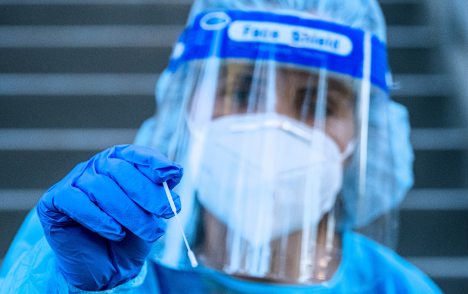Skilled Nursing Facilities: COVID-19
*CDPH no longer reports COVID-19 Resident and Healthcare Worker (HCW) Cases. This page is for historical purposes only.
The California Department of Public Health’s Center for Health Care Quality (CHCQ) is committed to protecting patient safety and ensuring quality care for residents in skilled nursing facilities (SNFs). The COVID-19 pandemic has highlighted the unique challenges facing many SNFs, which may include staffing shortages, lack of full-time Infection Preventionists, and lack of access to resources necessary to limit the spread of COVID-19 among the vulnerable SNF resident population.
CHCQ is taking a proactive approach to maintain access to quality care, and minimize infection and death rates in SNFs, among both residents and health care workers. CHCQ has worked to provide education and technical assistance to ensure that SNFs can implement necessary changes and actions. CHCQ surveyors have been onsite more frequently at SNFs during the COVID-19 pandemic to support SNFs on their infection control plans, and ensuring that those plans are fully implemented at the facility. When other actions are insufficient, enforcement actions are also an essential step to meet safety guidelines, have adequate resources, and protect residents' lives.
 Additional ways CHCQ is working with SNFs during the COVID-19 pandemic include:
Additional ways CHCQ is working with SNFs during the COVID-19 pandemic include:
Activating the Medical Health Coordination Center to have staff available 7 days a week to answer questions from SNFs and respond to resource requests;
Issuing more than 55 COVID-19-specific policy guidance documents and All Facility Letters, which include requirements for COVID-19 Mitigation Plans, visitations, the SNF Toolkit, and specific critical elements like baseline testing;
Hosting weekly All Facility Calls that average over 1,700 facility participants, to provide up-to-date information for testing, labs, infection control, and policies, as well as include a question-and-answer portion for state experts to answer real time questions and invite feedback;
Retraining and redirecting 600 CHCQ health facility evaluator nurses to work alongside all SNFs to provide infection control education during onsite visits to help ensure safety of residents and coordinate solutions for staffing and personal protective equipment resource needs;
Deploying strike teams to SNFs as necessary to assist in containing and mitigating outbreaks, conduct contact tracing risk exposure assessments, and coordinate testing with local health departments. CHCQ strike teams also assist SNFs with "cohorting," or separating residents who are COVID-19 positive and transferring and receiving residents as needed. These teams include health facility evaluator nurses, infection control specialists, and staff from local health departments. CHCQ has deployed strike teams to over 400 SNFs since the pandemic began.
Six Strategies for Skilled Nursing Facilities
Additionally, CHCQ is implementing six high-impact innovative strategies statewide that will provide long-term, sustainable changes to support skilled nursing facilities in infection control and mitigation.
 CHCQ is requiring all SNFs to develop a plan for baseline, screening, and response-driven testing of facility residents and health care workers (HCWs) to prevent the spread of infection in facilities and protect vulnerable SNF populations.
CHCQ is requiring all SNFs to develop a plan for baseline, screening, and response-driven testing of facility residents and health care workers (HCWs) to prevent the spread of infection in facilities and protect vulnerable SNF populations.
A testing and cohorting plan is one of six elements included in a facility's SNF COVID-19 Mitigation Plan, as required. SNFs have received direction and guidance via All Facilities Letters for the development and implementation of COVID-19 Mitigation Plans and resident and HCW testing strategies. CHCQ provides resources to SNFs for testing labs and staffing options and assists facilities with acquiring access to testing as needed. In addition, CHCQ provides ongoing technical assistance to SNFs that are encountering issues with reporting testing data, to ensure they have the guidance and support needed to provide accurate and complete data.

CHCQ's Healthcare-Associated Infections (HAI) program is leading a statewide effort to increase the number of Infection Preventionist positions within the program, develop dedicated infection prevention capacity in local health departments (LHDs), and increase the level and quality of infection prevention activity within SNFs.
The HAI program is tracking progress toward hiring additional state Infection Preventionists, who will be able to more quickly respond to serious infection concerns and provide proactive infection prevention support to all LHDs statewide. They are collaborating with LHDs to develop infection prevention support models so each LHD can better address COVID-19 and other infection prevention concerns in their jurisdictions.

Infection prevention assessment and technical assistance are vital duties performed by CHCQ surveyors in SNFs. The HAI program has developed an infection prevention education program that expands on the training of CHCQ surveyors, by focusing on evidence-based infection prevention care practices and current COVID-19 infection control guidance. This training will expand and improve the ability of surveyors to perform infection prevention assessment so that they can more fully serve their role in providing technical assistance to SNFs, and keeping them accountable.
 CHCQ is transitioning from annual state inspection surveys to increased on-site visits throughout the year to improve overall quality of care in SNFs, through frequent assessment and regulatory enforcement, and by providing more systematically recurrent feedback on non-compliance issues to SNF providers.
CHCQ is transitioning from annual state inspection surveys to increased on-site visits throughout the year to improve overall quality of care in SNFs, through frequent assessment and regulatory enforcement, and by providing more systematically recurrent feedback on non-compliance issues to SNF providers.
The Quality and Safety State SNF Survey Model is expected to result in significant improvements in outcomes and move facilities toward meeting minimum standards resulting in safer SNFs in California.

CHCQ is replacing its current paper-based quality and safety oversight state survey process with an electronic mobile survey application developed by Risk and Safety Solutions, a branch of the University of California, Office of the President. The mobile survey application will allow all onsite SNF surveys to be automatically integrated into a data analyticsdashboard for tracking of infection control and regulatory issues, as well as provide a portal for facilities to enter in plans of correction for approval. The mobile survey application will be rolled out to all 11,000 health care facilities regulated by CHCQ and the rollout will be prioritized by facility types most impacted by COVID-19, with an initial focus on SNFs.
 CHCQ, in collaboration with the California Health and Human Services (CHHS) Agency, has deployed an enhanced SNF COVID-19 daily reporting online survey that collects critical information from SNFs regarding staffing levels, personal protective equipment, and staffing needs.
CHCQ, in collaboration with the California Health and Human Services (CHHS) Agency, has deployed an enhanced SNF COVID-19 daily reporting online survey that collects critical information from SNFs regarding staffing levels, personal protective equipment, and staffing needs.
The COVID-19 survey reporting dashboard uses predictive analytics and modeling to project the spread and severity of COVID-19 in SNFs statewide. CHCQ is using this data to determine high-risk SNFs in order to prioritize resources and conduct daily contact with these high-risk facilities. Together, CHCQ and CHHS are using the dashboard and models to make data informed program and policy decisions to maintain access to care and minimize infection and death rates in SNFs among residents and staff.
For more information on each of these strategies, please click on the links or images above.